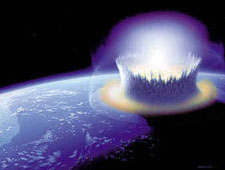
It appears that sixty-five million years ago, a gigantic meteor impacted the North Sea, leaving an underwater crater 20 kilometers in diameter Painting courtesy Don Davis.
Amid heightened public awareness of close-call asteroids, scientists have produced evidence for a 60- to 65-million-year-old impact in the North Sea some 320 kilometers northeast of London. The 3-km-wide and 300-meter-deep Silverpit crater (so named after the local fishing grounds) came to light during analysis of 3-D seismic data from a gas field 4 km down. The finding was published in this week's Nature.
Although the seismic maps showed a bowl-shaped feature in the deep rock from the Carboniferous period (more than 300 million years ago), geophysicist Philip J. Allen, a consultant for British Petroleum, was initially drawn to huge concentric structures in younger layers of chalk 1 km beneath the seabed. Allen was unsure what he had uncovered, so the mystery remained unresolved for a further six months.
It wasn't until a subsequent meeting with fellow British geologist Simon A. Stewart that greater credence was given to an asteroid impact as the source. Stewart had published a paper in Petroleum Geoscience arguing for just such an event given the alleged frequency of ancient catastrophes and the size of the North Sea.
Stewart noted the telltale conical peak at the center of Silverpit crater, the focus of at least 10 concentric rings that extend out to a radius of about 10 km. Given this data and an analysis of the underlying rock density, estimates for the diameter of the impacting body lie between 120 and 500 m.
During the Cretaceous era much of the British Isles laid beneath a shallow sea about 50 m deep, so the enormous energy released during the cataclysm would have generated huge tsunamis, devastating the island archipelago that would eventually form the highlands of Scotland.
But can we be sure this is an impact event? Allen and Stewart have analyzed seismic surveys of deeper rocks and magnetic data to rule out volcanism and other processes. They remain convinced: "We are as sure as we can be that Silverpit is the U.K.'s first impact crater."
 0
0
Comments
You must be logged in to post a comment.